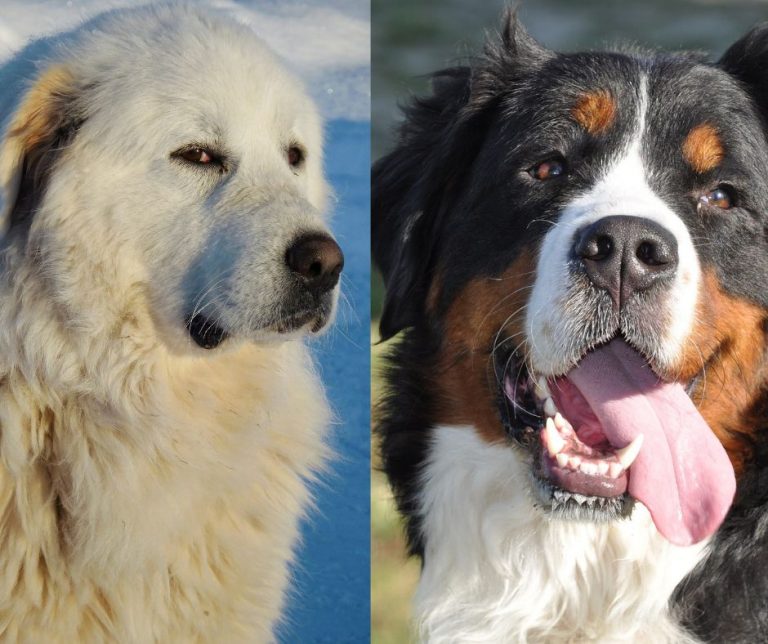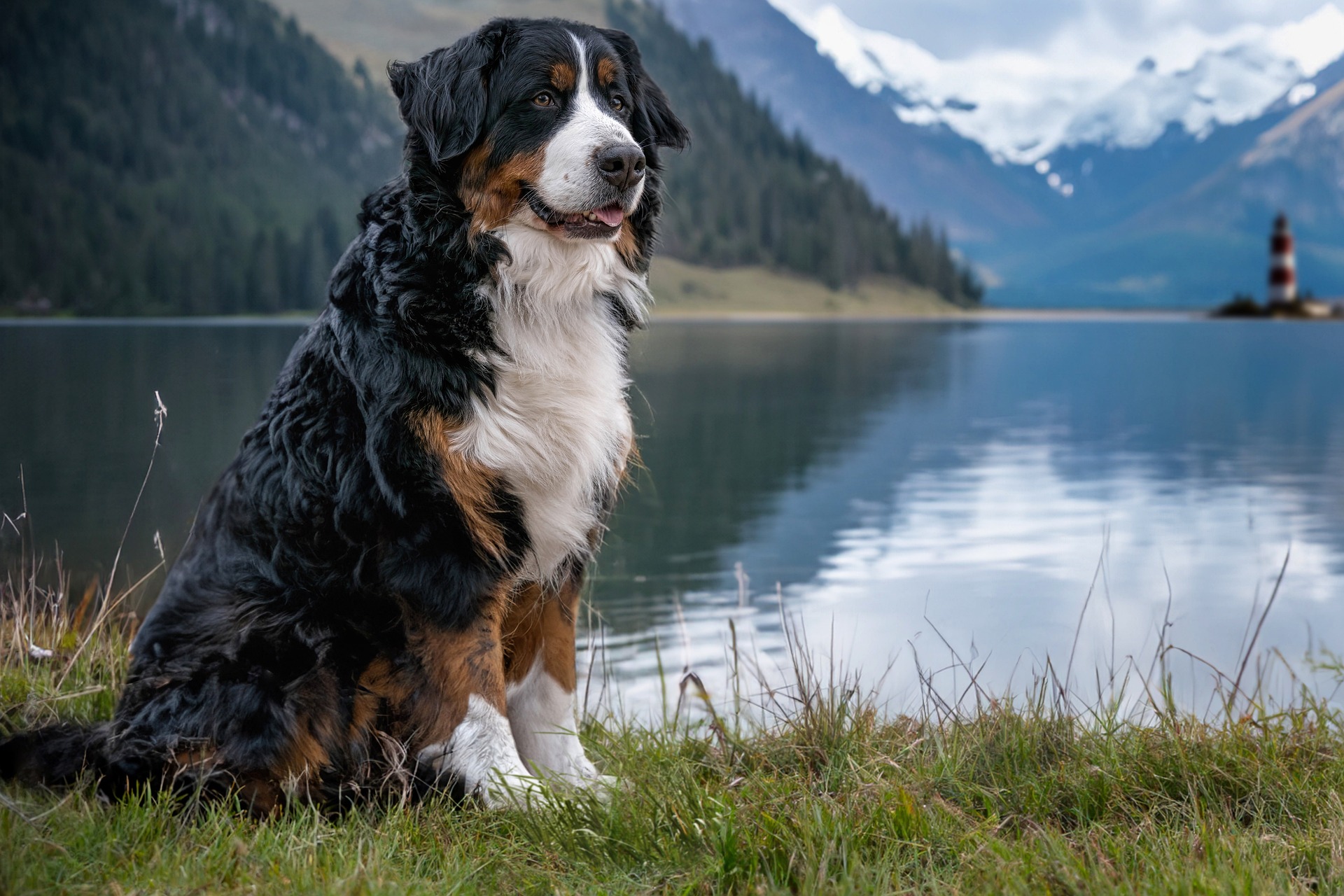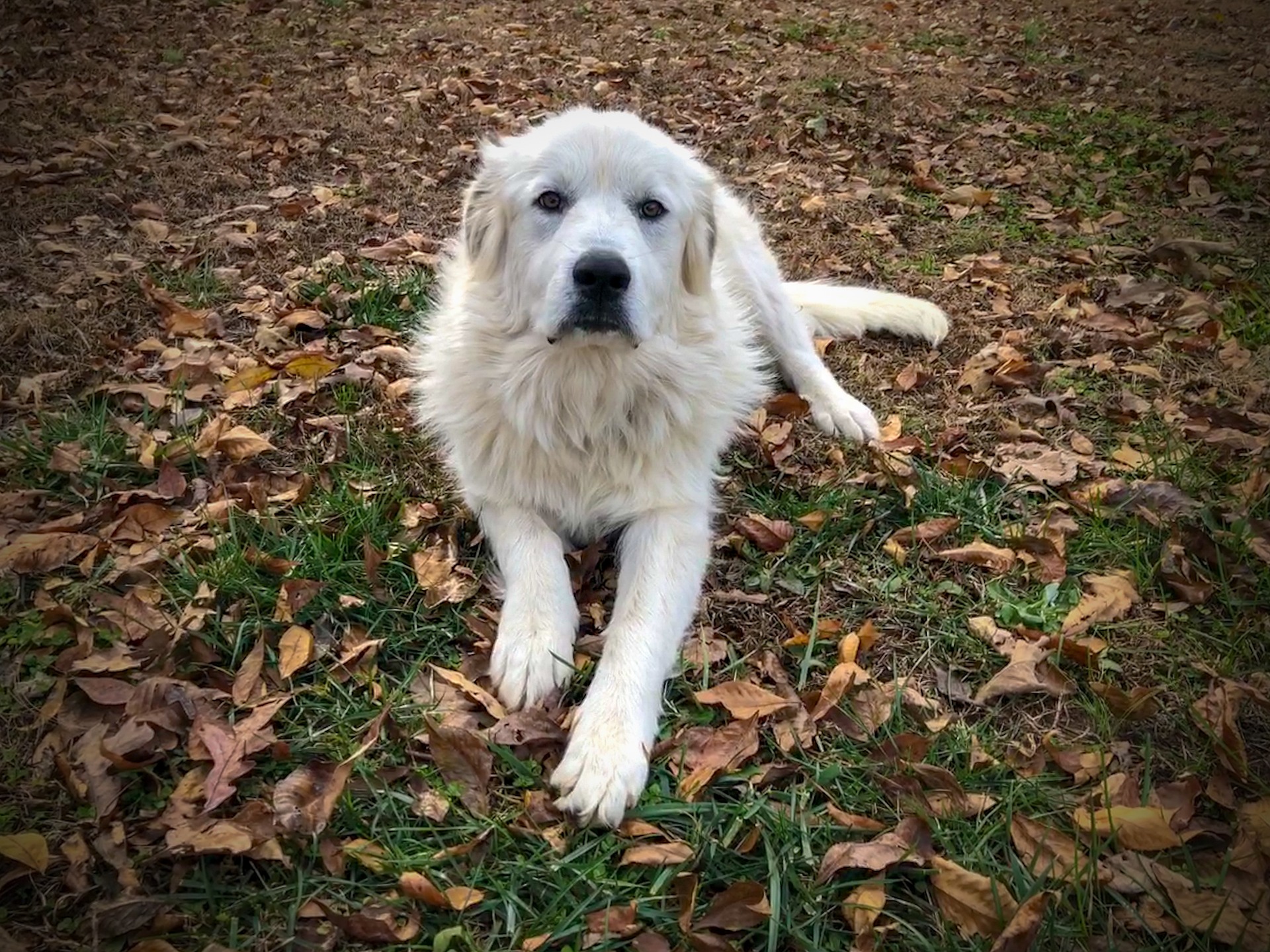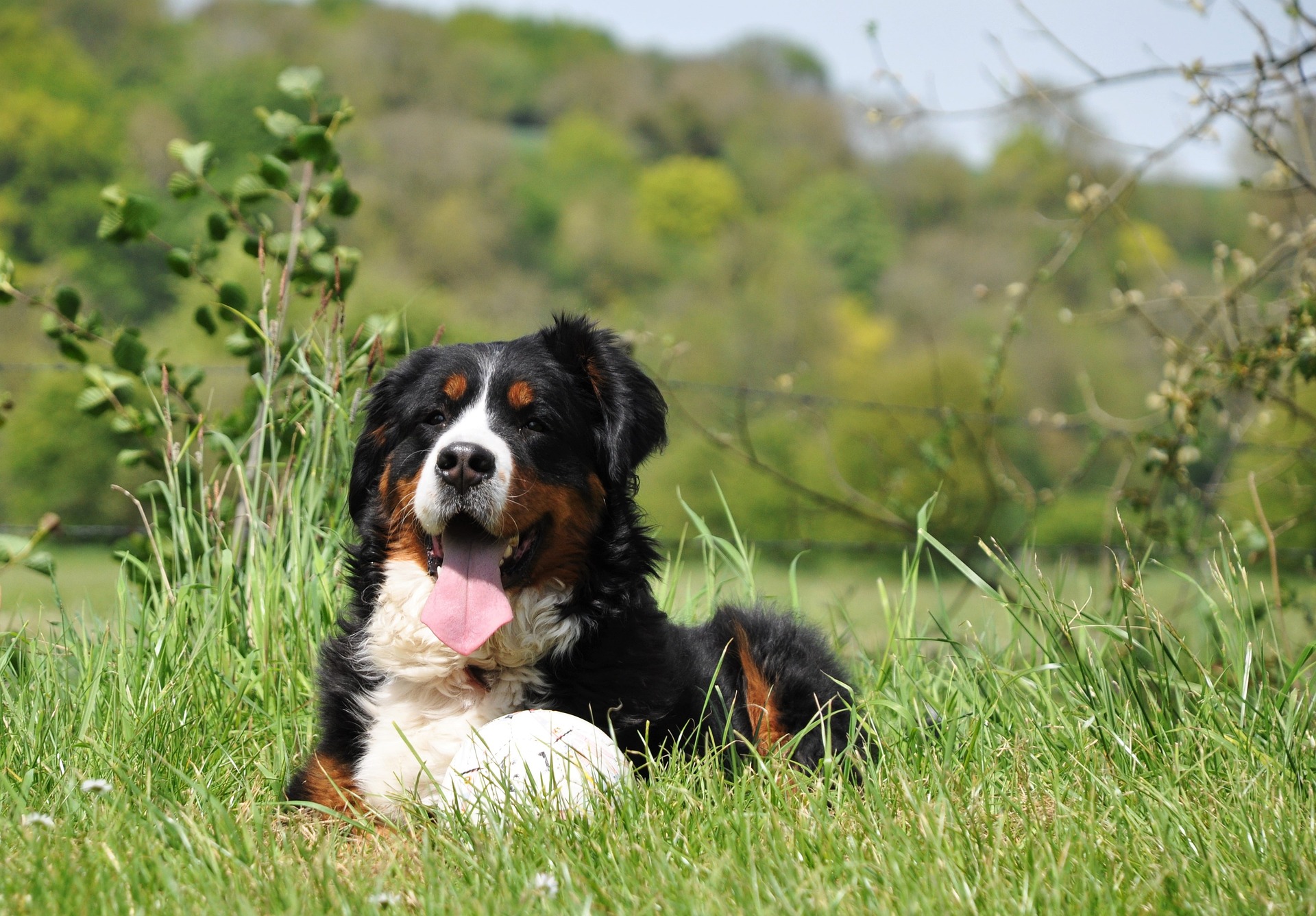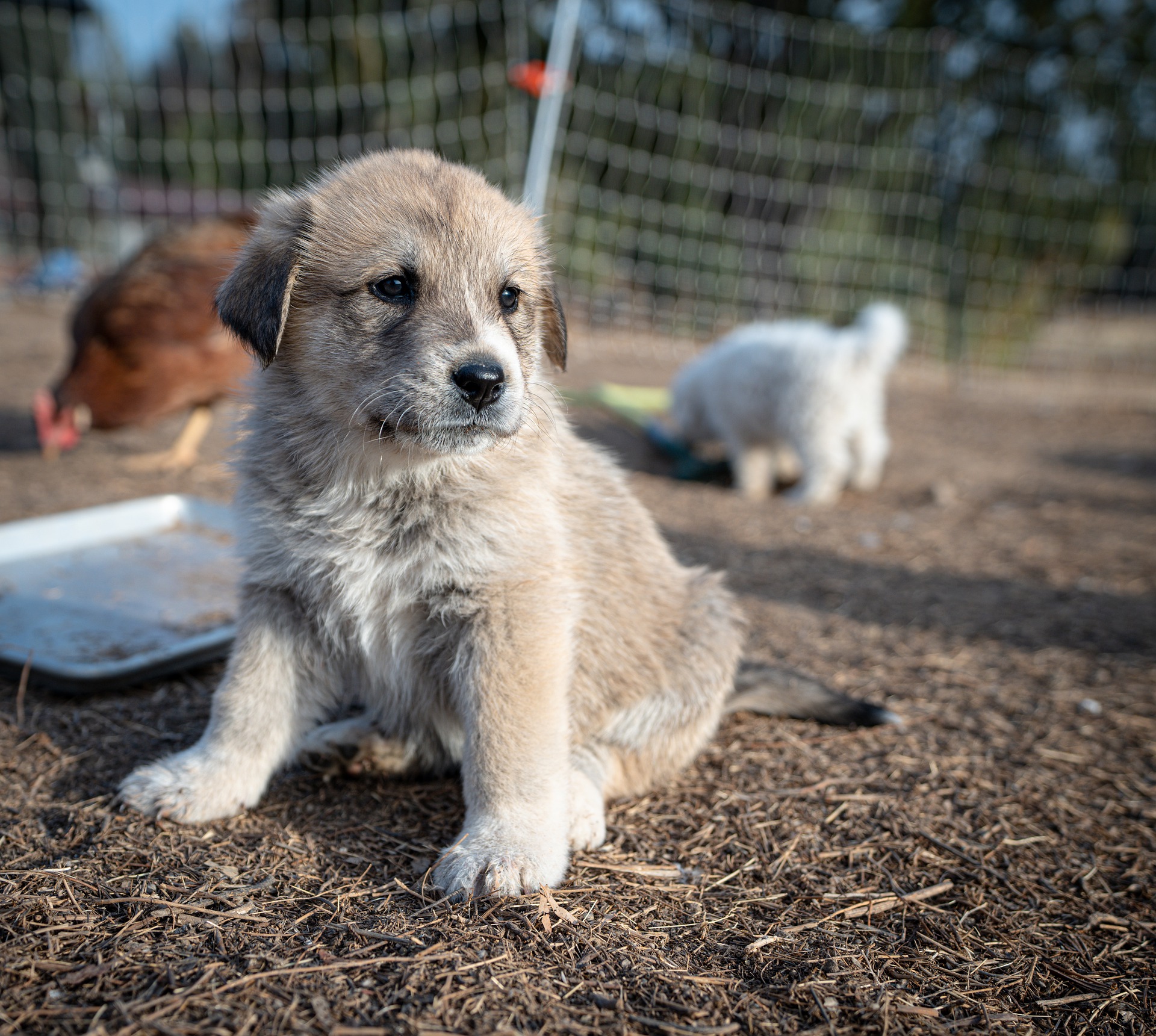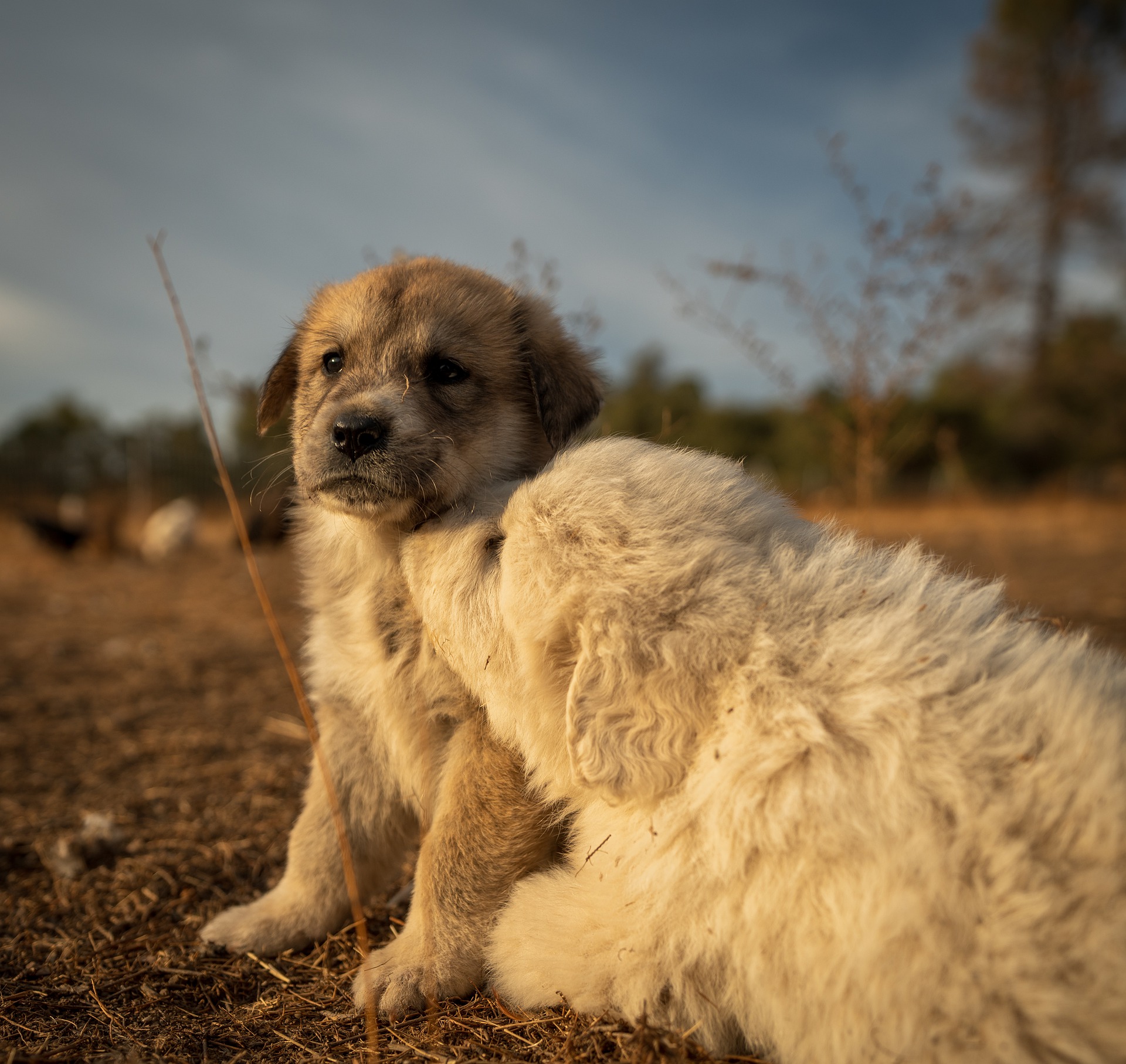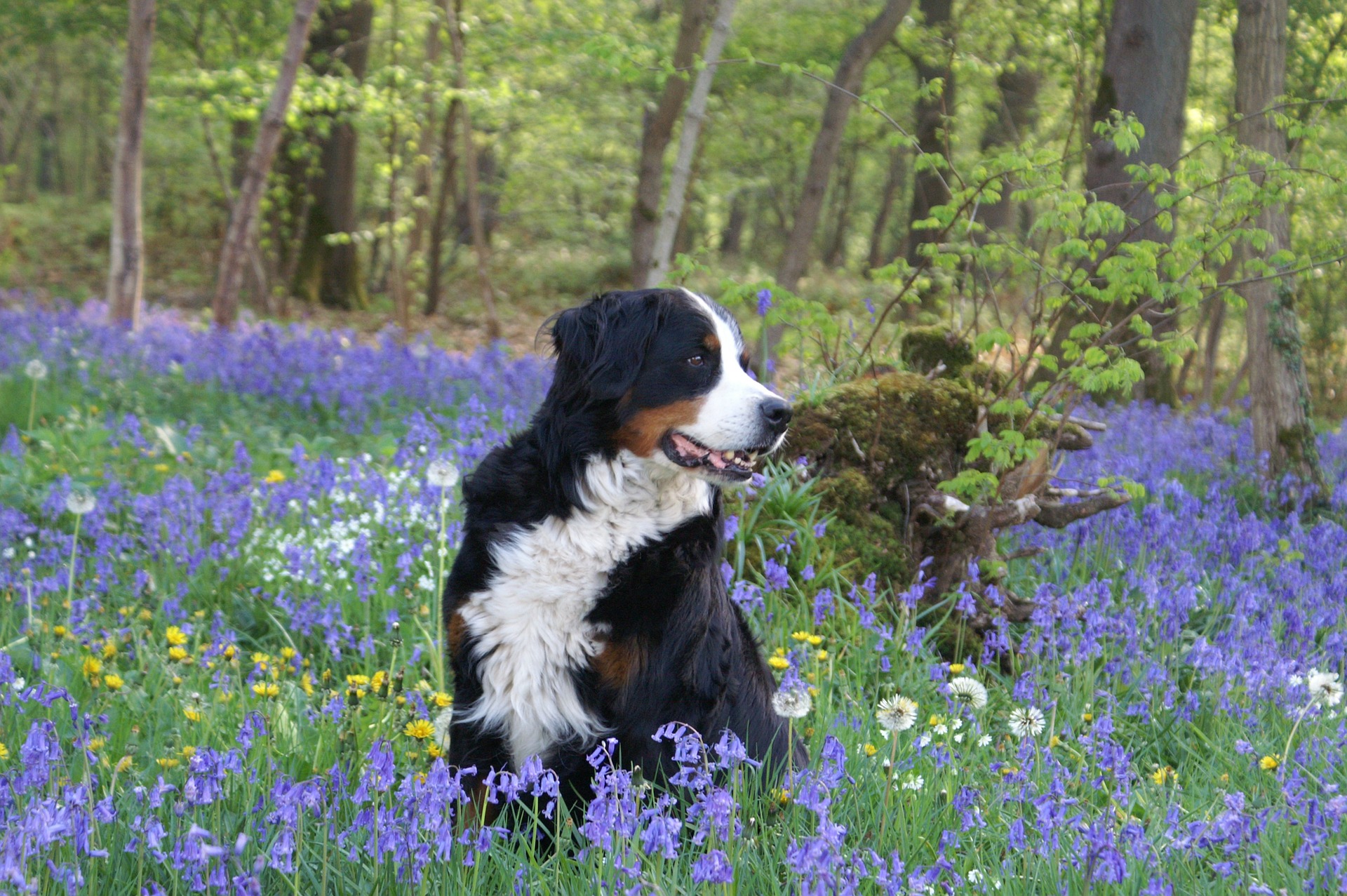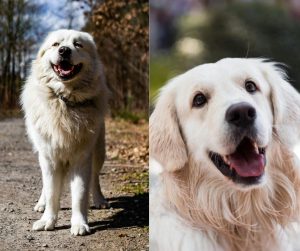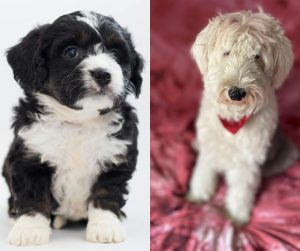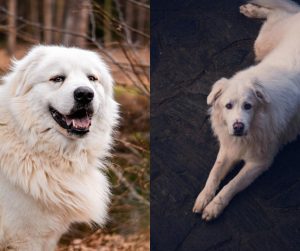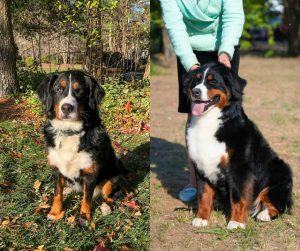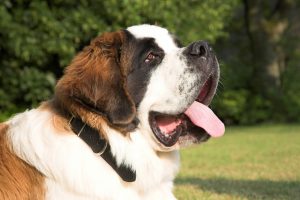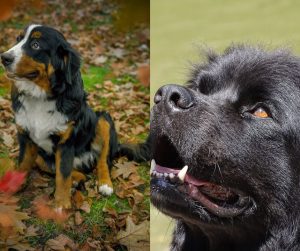When considering a fluffy companion to add to the family, the Bernese Mountain Dog and Great Pyrenees are two breeds that often come to mind. They share a striking presence with their thick fur and large stature, yet they have distinct characteristics that set them apart.
The Bernese Mountain Dog hails from the Swiss mountains where they were used for herding and pulling carts, while the Great Pyrenees has been guarding livestock in the Pyrenees Mountains of France and Spain for centuries. Their heritage not only shapes their physical attributes but also molds their temperament, making each breed suitable for different types of families and lifestyles.
Knowing the differences between these two gentle giant breeds is crucial for a prospective dog owner to choose the right fit for the home.
With their dense coats, the Bernese Mountain Dog and Great Pyrenees require considerable grooming, but their exercise and socialization needs vary, reflecting their distinct personalities.
Understanding these popular dog breeds goes beyond appreciating their working history; it’s about recognizing the Great Pyrenees’ independent guardianship contrasted with the Bernese Mountain Dog’s affectionate and loyal nature.
Consideration of these aspects ensures a harmonious match between the dog and their forever family. So, let’s compare dog breeds, Bernese Mountain Dog vs Great Pyrenees.
Key Takeaways
- The Bernese Mountain Dog and Great Pyrenees have specific grooming, exercise, and space requirements
- Their distinct historical roles have molded pronounced differences in temperament and activity levels
- Choosing the right breed depends on aligning the dog’s characteristics with the owner’s lifestyle and environment
Breed Origins and History
When it comes to canine companions with rich histories, the Bernese Mountain Dog and the Great Pyrenees are breeds with storied pasts that trace back to the mountains of Europe. These dogs not only share a heritage of working alongside humans but also hold distinct places in the cultures of their respective lands. Both large dog breeds are recognized by the American Kennel Club.
Bernese Mountain Dog Origin
The Bernese Mountain Dog hails from the pastoral lands of Switzerland, specifically the canton of Bern. Here, they found their niche as versatile farm dogs, with a history stretching back over 2,000 years. Swiss farmers deeply valued these dogs for their strength and gentle nature, utilizing them for pulling carts and herding cattle. By the early 20th century, however, they faced near extinction. Thanks to dedicated breeders, their numbers revived, securing their role today, not just on farms, but as beloved family pets.
Great Pyrenees Origin
On the other side of the mountainous regions, in France and Spain, the Great Pyr has a legacy just as commendable. These dogs were esteemed guardians of livestock in the Pyrenees mountain. Their presence there can be woven into tales that go back centuries, and they were even believed to be favored by royals. Their robust stature and watchful eyes made them ideal for deterring predators and protecting their charges, a job they undertake with solemn vigilance. As a guard dog, the Pyrenees is calm, yet protective.
Physical Characteristics
When one decides between a Bernese Mountain Dog vs Great Pyrenees, understanding their physical distinctions is essential. Not only do these breeds vary in size and weight, but their coats and overall appearances also present unique traits.
Size Comparison
Bernese Mountain Dog:
- Height: 22-27 inches
- Weight: 79-115 pounds
Great Pyrenees:
- Height: 25-32 inches
- Weight: Females over 85 pounds; Males over 100 pounds
The Bernese Mountain Dog and Great Pyrenees exhibit distinct differences in their size. The Bernese Mountain Dog is generally smaller than the Great Pyrenees, with males reaching up to 27 inches tall at the shoulder and weighing up to 115 pounds. On the other hand, the Great Pyrenees is a large dog breed that can stand up to 32 inches and, notably, there is no upper weight limit for this breed, making them potentially significantly larger and heavier than their Bernese counterparts.
Coat Description
Bernese Mountain Dog:
- Double coat: Long, silky outer; wooly undercoat
- Colors: Tricolored—black, white, rust
Great Pyrenees:
- Double coat: Weather-resistant outer; dense undercoat
- Colors: Predominantly white; may have markings of gray, tan, reddish-brown
Both dog breeds have a double coat, with Bernese Mountain Dogs featuring a long, silky outer coat accompanied by a wooly undercoat, which sheens beautifully when groomed. Their tricolor pattern—principally black with white and rust markings—is a distinguished feature. The Great Pyrenees’ double coat, conversely, consists of a weather-resistant outer layer and a dense undercoat, suited for guarding flocks in harsh climates. While their coats are predominantly white, they may sport shades of gray, tan, or reddish-brown, often seen on the head, ears, and tail.
In terms of physical build, the Bernese Mountain Dog carries with them a sturdy and agile body, a strong neck, and a regal head with a well-defined stop. The Great Pyrenees, impressive in stature, bears a commanding presence with their powerful body and a head that is slightly wedge-shaped, often giving an impression of elegance and nobility.
Personality and Temperament
When choosing between the Bernese Mountain Dog and the Great Pyr, it’s like finding a companion in a burly, gentle giant, whether they’re romping with kids or standing watch in your backyard. Both breeds wield a strong presence, marked by a loyal and affectionate nature that blends well with family life, matched by their watchful eye that makes them naturals at guarding the homestead.
Behavior with Children and Family
Bernese Mountain Dogs are known for their affectionate and friendly disposition, thriving in a family environment. They show a gentle patience with children, making them an excellent choice for a family pet. In comparison, Great Pyrenees are equally loyal and affectionate towards their families. They are calm but may be more independent and reserved, which requires respectful interactions, especially from young children.
Interaction with Strangers
Both breeds present different attitudes toward strangers; the Bernese is typically welcoming and friendly, eager to greet new faces with a wagging tail. On the flip side, the Great Pyrenees tends to be more cautious and reserved when it comes to unknown visitors, often taking time to warm up to someone new. This large breed has been bred to be protective and guard the property of its dog owner.
Guarding and Protective Traits
The protective instincts of a Great Pyrenees are strong and well-defined. They were bred to guard, so they take their role as a protector seriously, often being quite assertive when it comes to the safety of their home and family. Bernese Mountain Dogs also possess a loyal demeanor, but their guarding instincts are not as pronounced; they are more likely to slobber an intruder with kisses than to take a defensive stance.
Exercise and Activity Level
Bernese Mountain Dogs and Great Pyrenees have unique exercise and activity level needs that are essential to their health and happiness. These breeds thrive with proper physical and mental stimulation tailored to their specific characteristics.
Space and Living Environment Needs
Bernese Mountain Dogs are known for their moderate to high energy levels. They require daily exercise to maintain a healthy state of mind and body. A spacious environment is ideal for them, as they were bred for herding and have an instinctual need to move around. A house with a large, fenced yard is beneficial for this breed to roam and play. Without adequate space, they might develop behavioral issues due to pent-up energy.
Great Pyrenees dog breed, on the other hand, exhibit a lower energy level but they still need regular exercise to prevent boredom and promote good health. Despite their size, they can adapt to living in smaller spaces as long as they receive sufficient daily activity. These dogs historically guarded livestock and are content with patrolling their territory, which means a secure outdoor area is necessary for them to perform their natural guarding behaviors.
Suitability for Outdoor Activities
Both breeds enjoy outdoor activities, but their suitability for various types of exercise can differ.
Bernese Mountain Dogs are enthusiastic about playtime and activities like hiking, which can be attributed to their heritage as farm dogs in the Swiss mountains. Their playful nature makes them a good companion for outdoor adventures that require stamina and agility.
Meanwhile, Great Pyrenees appreciate a more leisurely pace. Their exercise can be fulfilled with walks or short play sessions; they don’t typically demand intense activity. They’re well-suited for a family who enjoys casual outdoor activities like walking or moderate hiking. However, it is crucial to ensure they don’t overheat in warm weather due to their thick coats.
Training and Socialization
When it comes to training and socialization, both the Bernese Mountain Dog and the Great Pyrenees have their unique traits. They are generally good-natured and capable of learning, but their distinct personalities call for varied approaches in training.
Trainability and Learning Speed
Bernese Mountain Dogs are known for their intelligence and eagerness to please. This combination often makes them quite responsive to training. They pick up new commands relatively quickly and are known for their patience, which can be a boon during training sessions. Essentially, if you’re looking for a friend who’s willing to learn and succeed together, the Bernese might just bring that crisp high-five to every lesson.
- Learning Speed: Quick
- Training Characteristics: Eager to please, Intelligent
In contrast, Great Pyrenees, while intelligent, can have an independent streak that might make training a bit more challenging. Patience and consistency are key, as they may not always be eager to follow commands as Bernese Mountain Dogs might.
Training them requires understanding their independent nature, which means sometimes they’d rather make their own decisions than follow orders. It’s like trying to suggest a new route to a seasoned captain—they’ll take heed if they trust you, but they’ve also got their own map.
- Learning Speed: Moderate
- Training Characteristics: Independent, Intelligent
Socializing with Other Dogs and Pets
The social skills of Bernese Mountain Dogs often shine when they’re with other pets. Their friendly demeanor generally makes them amiable companions to other dogs. It’s as if they have an innate sense for the social graces needed at the dog park.
- Socialization Tendencies: Friendly, Social
Great Pyrenees, historically being livestock guardians, can be protective and may require more careful socialization. They’re like the stoic guardians of the pet world—once they’ve made friends, they’re loyal for life, but they like to assess the field first. With early and positive experiences, they can become sociable pets who fit well into the family dynamic.
- Socialization Tendencies: Protective, but can be social with proper introduction
Training and socializing these breeds can be a richly rewarding experience, filled with mutual learning and respect.
Each dog’s personality shines through in different ways, but with kindness and consistency, they’ll become the well-mannered companions you hope for. Whether they’re fast learners or independent thinkers, or whether they’re making the rounds at the park or cautiously assessing their playmates, these dogs have hearts ready for friendship and minds ready for guidance.
Training Challenges and Rewards
Bernese Mountain Dogs are known for their eager-to-please attitudes, which generally makes them quite trainable. They respond well to positive reinforcement and are often motivated by praise and treats. However, this breed does require attention to keep them engaged due to their intelligence. Early socialization and training can harness their natural herding tendencies and ensure they’re well-behaved.
In contrast, Great Pyrenees are more independent and may appear stubborn at times. This independence comes from their guarding instincts, as they have been bred to make decisions on their own while protecting livestock. With consistent training, they can become reliable watchdogs. While they may not always seek approval as eagerly as Bernese Mountain Dogs, Great Pyrenees can be immensely rewarding to train, offering loyalty to those they trust.
Importance of Social Interaction
Socialization is crucial for both breeds. For the Bernese Mountain Dog, it helps in developing a well-rounded temperament and in preventing any overprotectiveness, especially since they are working dogs.
They’re generally good with families and other pets when properly socialized.
Great Pyrenees dogs benefit from early socialization to temper their guarding instincts. They should be introduced to a variety of people, pets, and environments to become well-adjusted adults.
Socialization helps to ensure that their protective nature doesn’t turn into aggression and that their energy level meets the family dynamics. They can be suitable for homes where they can have a job to do, reflecting their working dog heritage.
Health and Lifespan
When considering a Bernese Mountain Dog or a Great Pyrenees, prospective pet owners should be aware of each breed’s specific health concerns and expected lifespans.
These large breeds come with significant joy and companionship, but they also require owners to be vigilant about certain health issues that can affect their quality of life.
Common Health Issues
Both the Bernese Mountain Dog and the Great Pyrenees are prone to hip dysplasia and elbow dysplasia, conditions that involve abnormal formation of the respective joints and can lead to pain or lameness.
Monitoring weight and proper nutrition can be a helpful part of prevention, as excessive weight can exacerbate these conditions.
Bloat, or gastric torsion, is another serious condition that can occur in large, deep-chested breeds; quick action can be critical if bloat is suspected.
Breed-Specific Conditions
Bernese Mountain Dogs have a relatively short lifespan, often ranging between 6-10 years. Unfortunately, they have a predisposition to certain types of cancer, which is a leading cause of mortality in this breed.
Regular check-ups with a veterinarian can play a key part in early detection and management of health issues.
Great Pyrenees typically enjoy a longer lifespan, usually between 10-12 years, when properly cared for. This breed may also be impacted by progressive retinal atrophy, a genetic eye disorder, though it’s less common.
Maintaining a dialogue with a vet who’s familiar with these issues can help owners catch and manage potential conditions early on.
Grooming and Care
Preparing to groom a Bernese Mountain Dog or a Great Pyrenees goes beyond a quick brush; it involves a committed routine to manage their thick coats and keep them looking their best.
They share the need for thorough, regular grooming but have slightly different requirements due to their distinct coats.
Managing Shedding and Coat Health
Bernese Mountain Dog:
- Coat: Thick, long, and slightly wavy or straight
- Shedding: They shed moderately throughout the year and heavily during the shedding season
- Brushing: Daily brushing is recommended to prevent tangles and mats, especially during the shedding season
- Tools: A slicker brush, undercoat rake, and pin brush are essential
Great Pyrenees:
- Coat: Dense, long, and weather-resistant with a thick undercoat
- Shedding: Shedding is consistent year-round, increasing seasonally
- Brushing: Brushing a couple of times a week is advised; more often during periods of heavy shedding
- Tools: Similar to the Bernese, an undercoat rake, slicker brush, and a long-toothed comb are useful
Both breeds require regular attention to their coat to prevent build-up of debris and to maintain their coat’s health and sheen.
They may not always appreciate the grooming process, but regular, gentle sessions can help them become comfortable with the routine.
Bathing and Cleanliness
Bernese Mountain Dog:
- Bathing Frequency: Every 3-4 months or as needed
- Tips: Use a dog-specific shampoo and ensure thorough rinsing to avoid irritation
Great Pyrenees:
- Bathing Frequency: Generally every 4-6 months, unless they get particularly dirty
- Tips: Their thick coats take time to dry, so ensure they are completely dried to prevent any mildew or matting
Both breeds require their ears checked regularly for signs of infection and their nails trimmed to prevent discomfort or mobility issues.
While bathing times can be bonding moments, it’s important to make them as stress-free as possible by providing treats and praise. The ultimate goal is to keep them clean and comfortable.
Breed Comparisons and Suitability
When deciding between a Bernese Mountain Dog and a Great Pyrenees, it’s the nuanced differences and how they align with your lifestyle that ultimately guide your choice.
These large breeds share some similarities but also have distinct characteristics making them suitable for different homes and owners.
Differences and Similarities
Bernese Mountain Dog:
- Average height (adult): 23-27.5 inches
- Average weight (adult): 70-115 pounds
- Lifespan: 7-10 years
- Exercise: At least 1 hour per day
- Grooming needs: High
- Family-friendly: Yes
- Patience with children: High
- Other pet-friendly: Yes
- Protective nature: Moderate
- Trainability: Loyal, intelligent, eager to please
Great Pyrenees:
- Average height (adult): 25-32 inches
- Average weight (adult): 85+ pounds
- Lifespan: Typically around 10-12 years
- Exercise needs: Moderate; tolerates a more sedentary lifestyle
- Grooming needs: High due to thick coats
- Family-friendly: Yes
- Patience with children: High
- Other pet-friendly: Often good, with proper socialization
- Protective nature: High; innate guardians
- Trainability: Independent but can be trained with patience
Choosing the Right Dog for Your Lifestyle
When looking at suitability, one must consider several factors that include size, grooming requirements, exercise needs, and temperament.
- Size and Space: Both breeds are large and need ample space; they are not well-suited for small apartment living
- Family Settings: If you have children or other pets, both breeds can be a good fit. They are known for being family-friendly and gentle with kids
- Exercise Needs: Bernese Mountain Dogs require regular exercise and thrive on activity, making them an excellent choice for an active owner. In contrast, Great Pyrenees may cope better with less exercise
- Grooming Requirements: Both breeds have high grooming needs; anyone adverse to dog hair or without the time for regular grooming might consider a different breed
- Protective Nature: A Great Pyrenees may take the role of guardian more seriously, which is crucial if looking for a protective dog. A Bernese Mountain Dog, meanwhile, will be protective but may have a more moderate protective instinct

